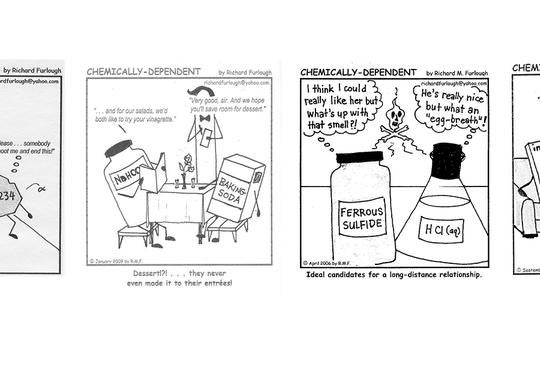Editor's note: This Acid Base Speed Dating was first published in Chemical Education Xchange (ChemEd X)! It is a community of chemistry educators strengthen by providing learning resources and forums for discussion and collaboration on an interactive platform.
The unit of acids and bases is difficult for most students in Advanced Placement Chemistry. The number of various calculations can be overwhelming. I decided it was time to make the pH calculations more exciting — acid base speed dating!
I posted a speed-dating PowerPoint on the board to guide students through this activity — sample slides are shown and available upon request. Email chem13news@uwaterloo.ca for these slides.
After completing notes and examples on each type of solution throughout the unit, my AP Chemistry students were given a handout to organize the calculations. The students completed a concept organizer in their own words (see next page) as a do-now and discussed their answers. After this quick review, each student was assigned a specific solution. I came up with 10 solutions that repeat depending on how many students are in the class. I had 32 students — there were eight strong acids, eight weak acids, eight strong bases and eight weak bases so all their future dates would have matches.
| List of solutions used | ||
|---|---|---|
| 10 mL | 1.0 M HA | Ka = 2.0 x 10-7 |
| 10 mL | 1.0 M HCl | |
| 10 mL | 1.0 M NH3 | Kb = 1.8 x 10-5 |
| 10 mL | 1.0 M NaOH | |
| 20 mL | 1.0 M HA | Ka = 2.0 x 10-7 |
| 20 mL | 1.0 M HCl | |
| 20 mL | 1.0 M NH3 | Kb = 1.8 x 10-5 |
| 20 mL | 1.0 M NaOH | |
| 40 mL | 1.0 M HA | Ka = 2.0 x 10-7 |
| 40 mL | 1.0 M NH3 | Kb = 1.8 x 10-5 |
The activity is easier when there are multiple students with the same solution. It makes finding a “date” faster because they have more than one person whom they could find a match. I made the quantities easy to calculate quickly and compare because the objective of the lesson was to recall the method to calculate the pH quickly, not to stump the students.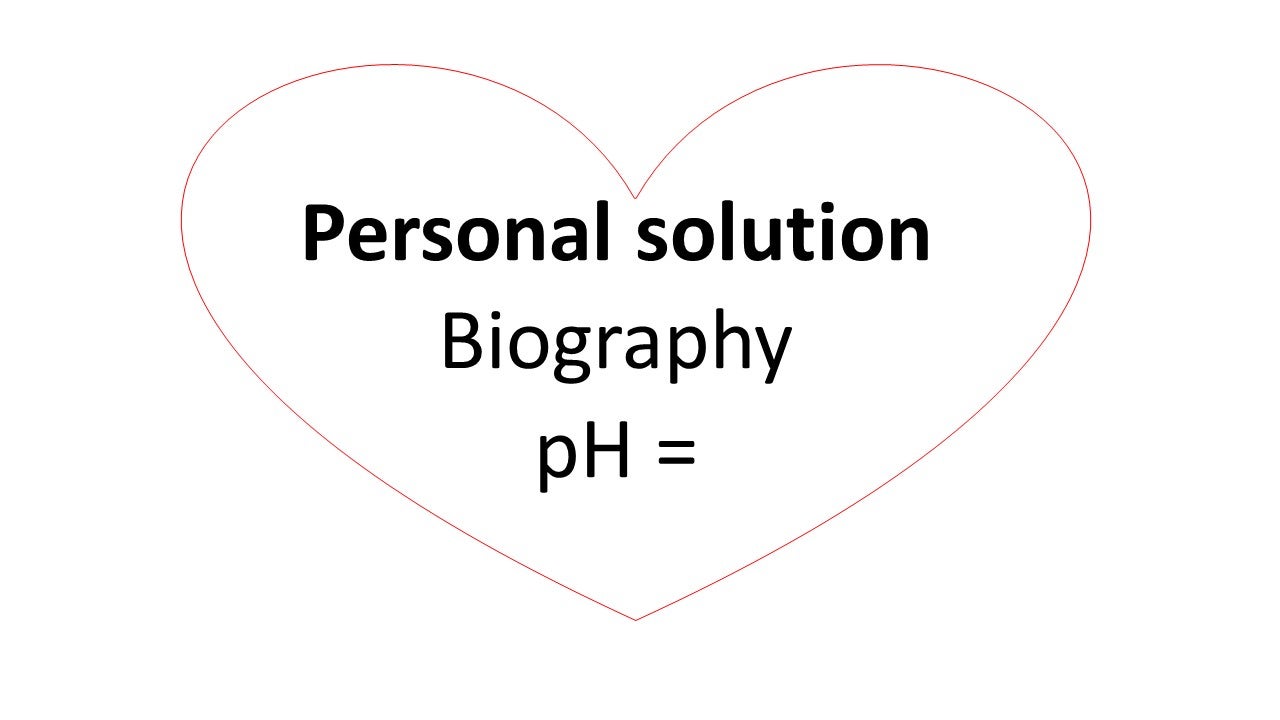 Each student was asked to determine their individual pH to complete their personal “Solution Biography” which they used for the entire activity.
Each student was asked to determine their individual pH to complete their personal “Solution Biography” which they used for the entire activity.
Then it was time to speed date! For each date, the students needed to find a specific match and determine their combined pH value.
Students were instructed on the type of match they were looking for via the slides. The students could get up and travel around speaking to each other in order to find a partner. When they found a partner they sat down together to begin their combined pH calculation. If students were unable to find a match, they stayed near the center of the room until only a few students were left. As matches sat down, I moved around to check their match. If the match was incorrect, they were sent to the middle of the classroom. Eventually everyone found a match (if there is an odd number of students you have to make a three-person match exception).
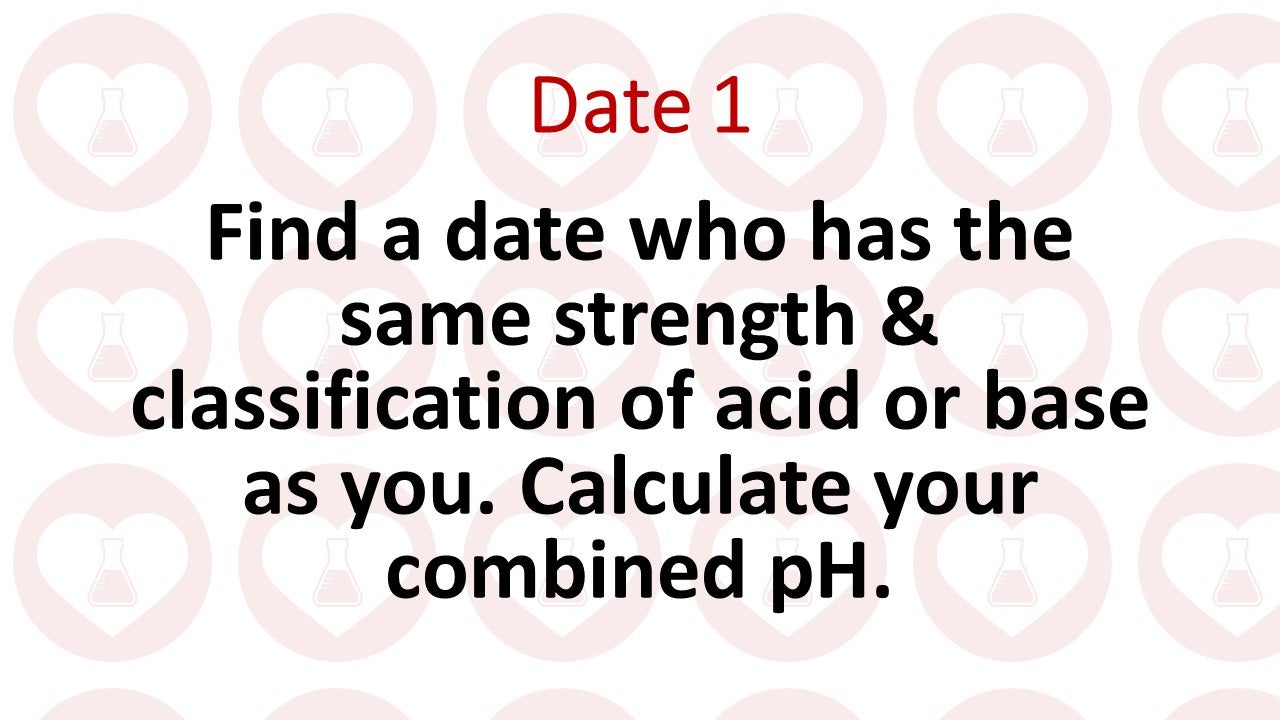
For date 1, students were asked to find a match where both solutions were of the same strength and classification — weak acid matching another weak acid or strong base matching another strong base. They were asked to calculate their combined pH value by calculating their combined moles, combined volume, combined molarity and finally combined pH. It was easy to check to make sure the students had the exact same type of solution — with varying volumes if needed — and the students didn’t seem to have a hard time finding matches. We summarized what happened to the pH — when two of the same concentrations were mixed the pH remained the same but when two different concentrations were mixed, the pH changed.
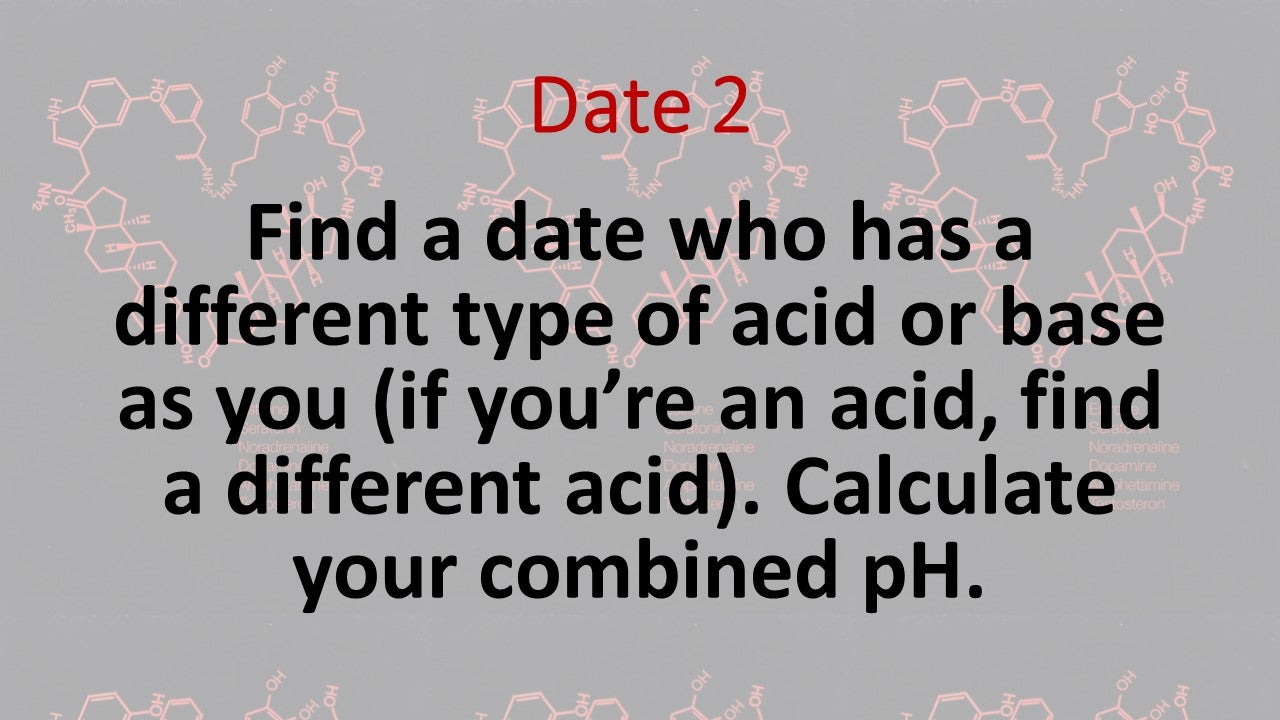
For date 2, students kept their initial solution and were asked to find another student with a similar solution of a different strength —for example a weak acid had to find a strong acid. They had to realize that the solution of the stronger acid determined the pH, but only after being diluted by the solution of the weaker acid. I would just have the matched pairs tell me what they had — strong acid or weak base — to ensure the matches were correct. The students didn’t have a hard time finding matches. We wrote out the steps to calculate the pH, which included diluting the strong substance to the combined value and then taking the negative log of the new diluted molarity.
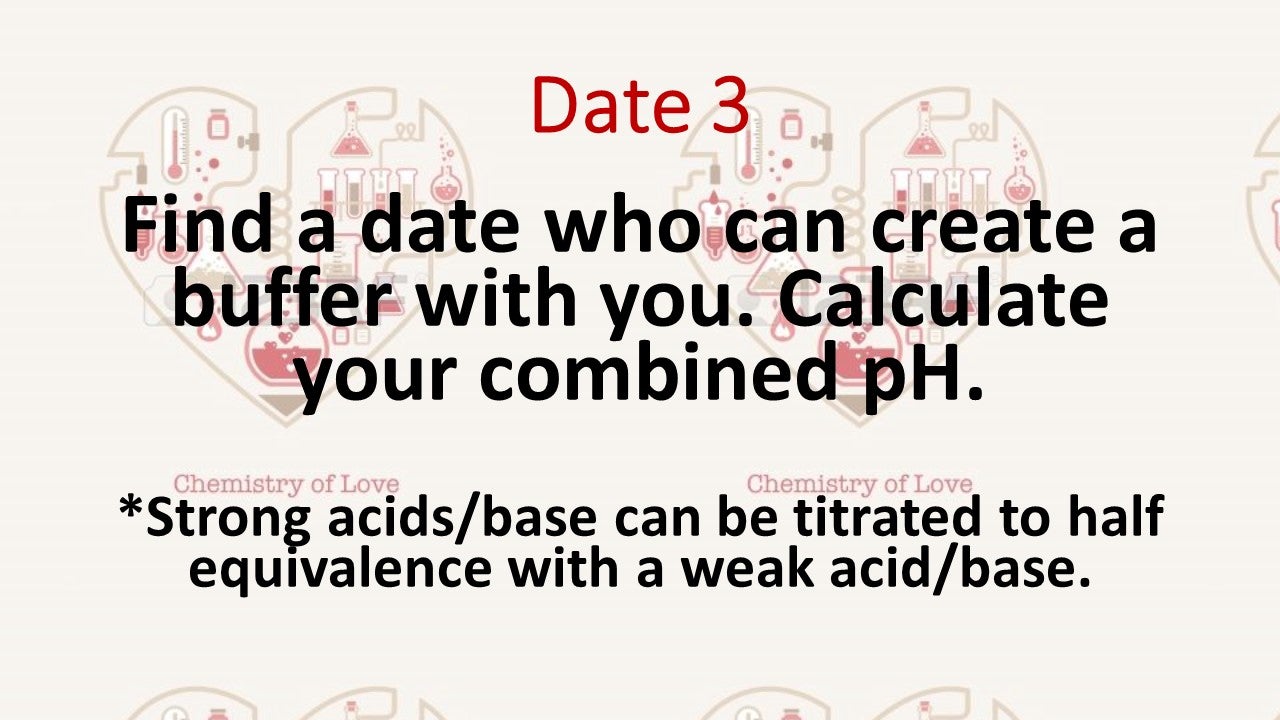
Date 3 was tricky! The students had to find a partner to make a buffer solution with. Some students had a difficult time finding dates, so after the initial dates were found we had a pool of students in the center of the room. To help everyone find a match I went around and checked the solutions to confirm their match was in fact a weak species and a strong alternate species in which there were more moles of weak than strong. The biggest takeaway was the students realized they needed to pair up to achieve a solution in which the weak solution contains more moles than the strong solution. Once students were given time to calculate their combined pH we wrote out the steps including writing the reaction between the two solutions, calculating the amount of salt produced and then using the Henderson-Hasselbalch equation to calculate the new pH. This pairing took the longest to match up, but I think the understanding of a buffer solution was well reviewed in the process. 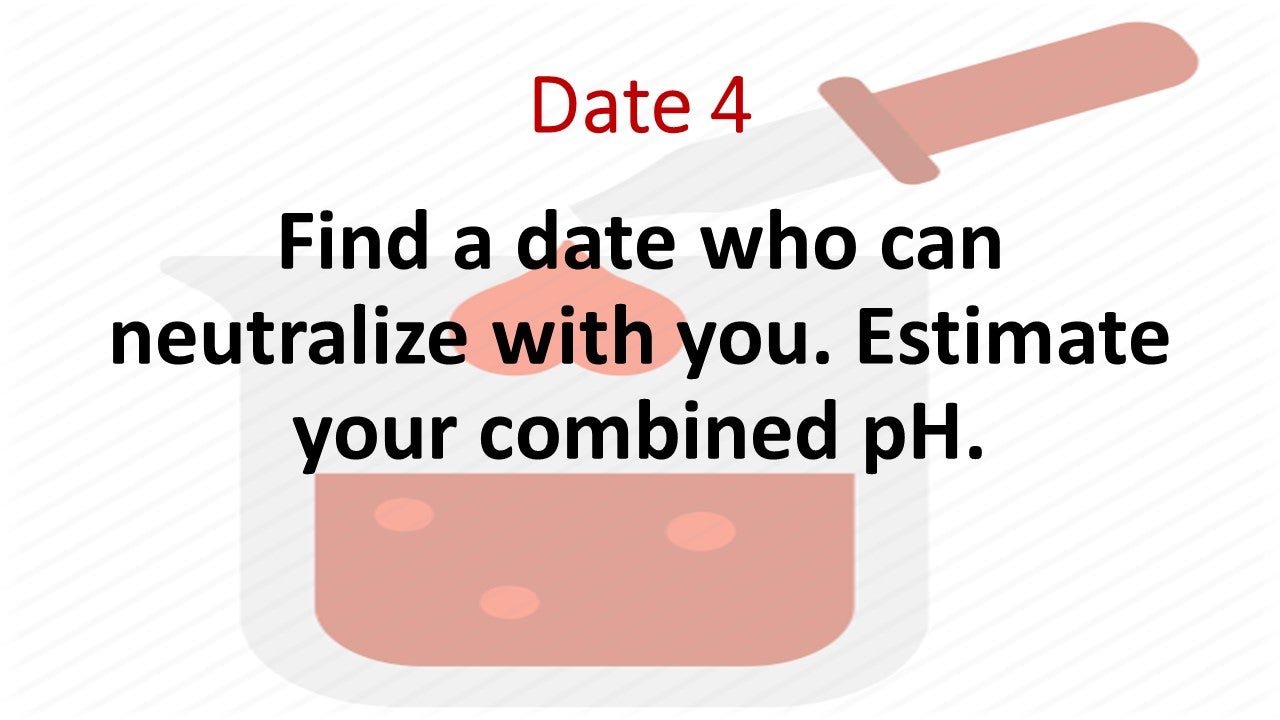
Our last date (date 4) required students to find a match to create a salt. They had to estimate the final pH, indicating whether the solution would result in a neutral, acidic or basic salt. The students realized that they had to find a match with equivalent moles. I rarely needed to intervene, unless the solutions were not the same quantity. After all students were matched, each pair read their individual solutions and in unison reported their salt type and estimated pH (7, higher than 7 or lower than 7). The trickiest examples were matches in which both solutions contained weak electrolytes (in which case the students had to compare K values).
Quick tips
- You can make modifications to the activity but keep in mind when you are modifying the solutions list that the trickier the numbers are, the harder it will be for the students to find a match quickly.
- Make sure everyone will indeed have a match for each date. For an uneven number of students, I had two struggling learners pair up as one solution.
- You may also choose to differentiate the students by assigning weak solutions to your best performers and strong solutions to your struggling learners.
- You can also choose to change the solution for each date if you want students to experience “being” different solutions.
- We completed the activity in 50 minutes.
I observed smiling, excited students eager to find matches. After class I asked a few students what they thought of the activity. All students said it was more fun than normal problem sets and would love to play again. Another student remarked that she “understands dilutions and strength much better now.” And my favorite quote of the day was “I can’t leave my match, we made a perfect buffer and we resist change!”
Student acid/base organizer
How do you calculate the pH of the following?
| pH process | Type of acid | Type of base |
|---|---|---|
| A solution of... | A strong acid | A strong base |
| A solution... | A weak acid | A weak base |
| A titration with... | A strong acid left over |
A strong base left over |
| A titration with... | A weak acid left over |
A weak base left over |
| A titration with... | A basic salt left over |
An acidic salt left over |
| A titration with... | A neutral salt left over |




